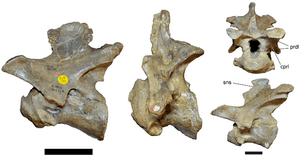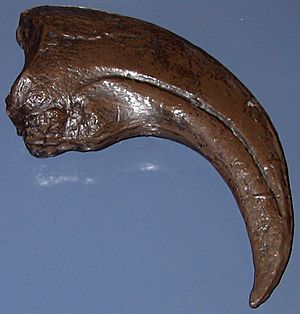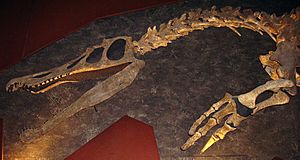Baryonyx facts for kids
Quick facts for kids Baryonyx |
|
|---|---|
 |
|
| Baryonyx | |
| Scientific classification | |
| Kingdom: | |
| Phylum: | |
| Class: | |
| Superorder: | |
| Order: | |
| Suborder: | |
| Family: | |
| Subfamily: | |
| Genus: |
Baryonyx
Charig & Milner, 1986
|
| Species | |
|
B. walkeri Charig & Milner, 1986 (type) |
|
Baryonyx was a carnivorous dinosaur discovered in clay pits just south of Dorking, England, and also in northern Spain. It has been dated to the Barremian period of Early Cretaceous Period, around 125 million years ago.
It was first discovered in 1983 by William Walker, who was an English amateur fossil hunter. A group of scientists lead by Alan J. Charig and Angela C. Milner of the Natural History Museum examined the skeleton and named Baryonyx walkeri, after the man who discovered it. Other good skeletons were discovered in England and in Spain, which gave scientists a good idea of what the dinosaur was like.
Baryonyx probably grew up to 8.5 meters long, with claws which were up to 35 centimeters long. It ate fish, like a grizzely bear would.
Contents
Description

In 2010, Baryonyx was estimated to have been 7.5 m (25 ft) long and to have weighed 1.2 t (1.3 short tons). It was estimated at 10 m (33 ft) in 1997, and 9.5 m (31 ft) long, 2.5 m (8.2 ft) in hip height, and 1.7 t (1.9 short tons) in weight in 1988. The fact that elements of the skull and vertebral column of the B. walkeri holotype specimen (NHM R9951) do not appear to have co-ossified (fused) suggests that the individual was not fully grown, and the mature animal may have been much larger (as attested by the size of the related Spinosaurus, which reached 15 m (49 ft) and 10 t (11 short tons). On the other hand, the specimen's fused sternum indicates that it may have been fairly mature. The second-best-preserved specimen (ML1190) was about the same size as the holotype skeleton.
The skull of Baryonyx is incompletely known, and much of the middle and hind portions are not preserved. The full length of the skull has been estimated to be 950 mm (37.4 in), based on comparison with that of the related genus Suchomimus (which is 20% larger). It was elongated, and the front 170 mm (6.6 in) of the premaxillae formed a long, low snout (rostrum) with a rounded upper surface. The nostrils, far back from the tip, passed horizontally from one side of the skull to the other.
Baryonyx had a rudimentary secondary palate, similar to crocodiles but unlike most theropod dinosaurs. A rugose (roughly wrinkled) surface suggests the presence of a horny pad in the roof of the mouth. It had a sagittal crest above the eyes, on the upper mid-line of the nasal bones, which was triangular, narrow, and sharp in front. The lacrimal bone in front of the eye appears to have formed a horn core similar to those seen, for example, on Allosaurus. The dentary was very long and shallow, with a prominent Meckelian groove. The rest of the lower jaw was fragile; the hind third was much thinner than the front, with a blade-like appearance. The front part of the dentary curved outwards to accommodate the large front teeth, and this area formed the mandibular part of the rosette. The dentary had many foramina (openings), which were passages for nerves and blood vessels. It has been suggested that some of Baryonyx's cranial bones had been misidentified (resulting in the occiput's too-deep reconstruction), and the skull was probably as low, long and narrow as that of the closely related Suchomimus.
Most of the teeth found with the holotype specimen were not attached to the skull; a few remained in the upper jaw, and only small replacement teeth were in the lower jaw. The teeth had the shape of recurved cones, flattened somewhat sideways. The larger teeth were less recurved than the smaller ones, but were otherwise uniform. The roots were very long, and the teeth slender. The carinae (edges) of the teeth were finely serrated with denticles on the front and back. There were seven narrow, uniform denticles per millimetre (0.039 in), more than in most theropods. Some of the teeth were fluted, with six to eight ridges along the length of their inner sides and fine-grained enamel. The inner side of each tooth row had a bony wall. The number of teeth was large, with seven teeth in the right premaxilla (other theropods have three to five) and thirty-two in the dentary, where sixteen is typical. The lower jaw would have had sixty-four teeth, and the difference between the number of teeth in the upper and lower jaws is more pronounced than in other theropods. The teeth in the dentary were more densely packed than those in the maxilla, and probably smaller. The terminal rosette in the upper jaw had thirteen dental alveoli (tooth sockets), six on the left and seven on the right side; the first four were large (with the second and third the largest), while the fourth and fifth progressively decreased in size. The diameter of the largest was twice that of the smallest. The first four alveoli of the dentary (corresponding to the tip of the upper jaw) were the largest, with the rest more regular in size. Interdental plates were between the alveoli.
The neck formed a straighter S shape (a sigmoid curve typical of theropods) than that seen in other theropods; in fact, the neck was initially thought to lack the S curve. The shape of the cervical vertebrae indicate that they tapered towards the head and were progressively longer front to back. The neural spines of the cervical vertebrae were low, thin, and were not always sutured to the centra (the bodies of the vertebrae). The axis vertebra, small relative to the size of the skull, had a well-developed hyposphene. The centra of the dorsal vertebrae were similar in size. Like other dinosaurs, Baryonyx reduced its weight (skeletal pneumaticity) with fenestrae (openings) in the neural arches and with pleurocoels (hollow depressions) in the centra (primarily near the transverse processes). From front to back, the neural spines of the dorsal vertebrae changed from short and stout to tall and broad.
The scapulae (shoulder blades) were robust; the bones of the forelimb were short in relation to the animal's size, but broad and sturdy. The humerus was short and stout, with its ends broadly expanded and flattened—the upper side for the deltopectoral crest and muscle attachment and the lower for articulation with the radius and ulna. The radius was short, stout and straight, and the olecranon of the ulna apparently very powerful. The lower part of the ulna had a broad expansion. The hands had three fingers; the first finger bore a large claw (ungual bone) measuring about 31 cm (12 in) along its curve, which would have been lengthened by a keratin sheath in life. Apart from its size, the claw's proportions were fairly typical of a theropod; it was bilaterally symmetric, slightly compressed, smoothly rounded, and sharply pointed. A groove for the sheath ran along the length of the claw. The pubic foot of the pelvis was not expanded.
History of discovery
On 7 January 1983 amateur fossil hunter William J. Walker discovered a large claw, a phalanx bone, and part of a rib in Smokejacks Pit, a clay pit near Ockley in Surrey, England. The tip of the claw was missing, but Walker found it a week later. British palaeontologists Alan J. Charig and Angela C. Milner examined the finds at the Natural History Museum of London and found more bones at the site on 7 February, but the entire skeleton could not be collected until May and June due to conditions at the pit. A team of eight museum staff members and several volunteers excavated two tonnes of matrix. Walker donated the claw to the museum, and the Ockley Brick Company (owners of the pit) donated the rest of the skeleton and provided equipment. The area had been explored for 200 years, but no similar remains had been found before.
Most of the bones collected were encased in siltstone nodules surrounded by fine sand and silt, with the rest lying in clay.
Fossils from other parts of the UK and Iberia, mostly isolated teeth, have subsequently been attributed to Baryonyx or similar animals.
Classification
| Spinosauridae |
|
||||||||||||||||||||||||
Palaeobiology
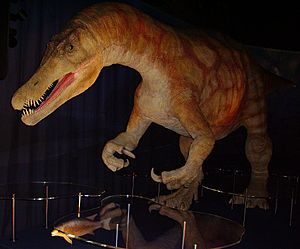
Diet and feeding
In 1986 Charig and Milner first suggested that its elongated snout with many finely serrated teeth indicated that Baryonyx was piscivorous (a fish-eater), speculating that it crouched on a riverbank and used its claw to gaff fish out of the water (similar to the modern grizzly bear). In 1984, Taquet pointed out that the spinosaurid snouts from Niger were similar to those of the modern gharial and suggested a behaviour similar to herons or storks. In 1997 Charig and Milner rejected their initial proposal that the articulation between the premaxilla and maxilla was mobile. In 1987 Andrew Kitchener disputed the piscivorous behaviour of Baryonyx and suggested that it would have been a scavenger, using its long neck to feed on the ground, its claws to break into a carcass, and its long snout (with nostrils far back for breathing) for investigating the body cavity. Kitchener argued that Baryonyx's jaws and teeth were too weak to kill other dinosaurs and too heavy to catch fish, with too many adaptations for piscivory. According to R. E. H. Reid, a scavenged carcass would have been broken up by its predator and large animals capable of doing so—such as grizzly bears—are also capable of catching fish (at least in shallow water).

In 1997, Charig and Milner demonstrated direct dietary evidence in the stomach region of the B. walkeri holotype. It contained the first evidence of piscivory in a theropod dinosaur, acid-etched scales and teeth of the common fish Scheenstia mantelli (then classified in the genus Lepidotes), and abraded bones of a young Iguanodon. An apparent gastrolith (gizzard stone) was also found. They also presented circumstantial evidence for piscivory, such as crocodile-like adaptations for catching and swallowing prey: long, narrow jaws with their "terminal rosette", similar to those of a gharial, and the downturned tip and notch of the snout. In their view, these adaptations suggested that Baryonyx would have caught small to medium-sized fish in the manner of a crocodilian: gripping them with the notch of the snout (giving the teeth a "stabbing function"), tilting the head backwards, and swallowing them headfirst. Larger fish would be broken up with the claws. That the teeth in the lower jaw were smaller, more crowded and numerous than those in the upper jaw may have helped the animal grip food. Charig and Milner maintained that Baryonyx would primarily have eaten fish (although it would also have been an active predator and opportunistic scavenger), but it was not equipped to be a macro-predator like Allosaurus. They suggested that Baryonyx mainly used its forelimbs and large claws to catch, kill and tear apart larger prey.
In 2004, a pterosaur neck vertebra from Brazil with a spinosaurid tooth embedded in it confirmed that the latter were not exclusively piscivorous. A 2007 finite element analysis of CT scanned snouts indicated that the biomechanics of Baryonyx were most similar to those of the gharial and unlike those of the American alligator and more-conventional theropods, supporting a piscivorous diet for spinosaurids. Their secondary palate helped them resist bending and torsion of their tubular snouts. A 2013 beam-theory study compared the biomechanics of CT-scanned spinosaurid snouts with those of extant crocodilians, and found the snouts of Baryonyx and Spinosaurus similar in their resistance to bending and torsion. Baryonyx was found to have relatively high resistance in the snout to dorsoventral bending compared with Spinosaurus and the gharial. The authors concluded (in contrast to the 2007 study) that Baryonyx performed differently than the gharial; spinosaurids were not exclusive piscivores, and their diet was determined by their individual size.
A 2016 study found that adult spinosaurs could displace their mandibular rami (halves of the lower jaw) sideways when the jaw was depressed, which allowed the pharynx (opening that leads from the throat to the stomach) to be widened. This jaw-articulation is similar to that seen in pterosaurs and living pelicans, and would likewise have allowed spinosaurids to swallow large prey such as fish and other animals. Another 2016 study found that the jaws of spinosaurids were convergent with those of pike conger eels; these fish also have sideways compressed jaws (whereas the jaws of crocodilians are compressed from top to bottom), an elongated snout with a "terminal rosette" that bears enlarged teeth, and a notch behind the rosette with smaller teeth. This type of jaws were likely evolved for grabbing prey in aquatic environments with low light, and may have helped in prey detection.
Movement and aquatic habits
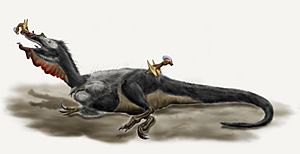
In their original description, Charig and Milner did not consider Baryonyx to be aquatic (due to its nostrils being on the sides of its snout—far from the tip—and the form of the post-cranial skeleton), but thought it was capable of swimming, like most land vertebrates. They speculated that the elongated skull, long neck, and strong humerus of Baryonyx indicated that the animal was a facultative quadruped, unique among theropods. In their 1997 article they found no skeletal support for this, but maintained that the forelimbs would have been strong enough for a quadrupedal posture and it would probably have caught aquatic prey while crouching—or on all fours—near (or in) water. A 2014 re-description of Spinosaurus based on new remains suggested that it was a quadruped, based on its anterior centre of body mass. The authors found quadrupedality unlikely for Baryonyx, since the better-known legs of the closely related Suchomimus did not support this posture.
In 2017, David E. Hone and Thomas R. Holtz pointed out that (like other theropods) there was no reason to believe that the forelimbs of Baryonyx were able to pronate, and thereby make it able to rest or walk on its palms. Resting on or using the forelimbs for locomotion may have been possible (as indicated by tracks of a resting theropod), but if this was the norm, the forelimbs would probably have showed adaptations for this. They furthermore suggested that the forelimbs of spinosaurids do not seem optimal for trapping prey, but instead appear similar to the forelimbs of digging animals. They suggested that the ability to dig would have been useful when excavating nests, digging for water, or to reach some kinds of prey. Hone and Holtz also believed that spinosaurids would have waded and dipped in water rather than submerging themselves, due to their sparsity of aquatic adaptations.
Images for kids
-
Reconstruction of the holotype skull, Museon, The Hague
-
Skeletal diagram of the holotype specimen (below) compared with the related genus Suchomimus
-
Distribution of spinosaurids in Europe and North Africa during the Cretaceous; 1, 3, 4, 5, 6 are Baryonyx
-
Spatial distribution of abelisaurids, carcharodontosaurids, and spinosaurids (the latter strongly associated with coastal environments)
See also
 In Spanish: Baryonyx walkeri para niños
In Spanish: Baryonyx walkeri para niños




